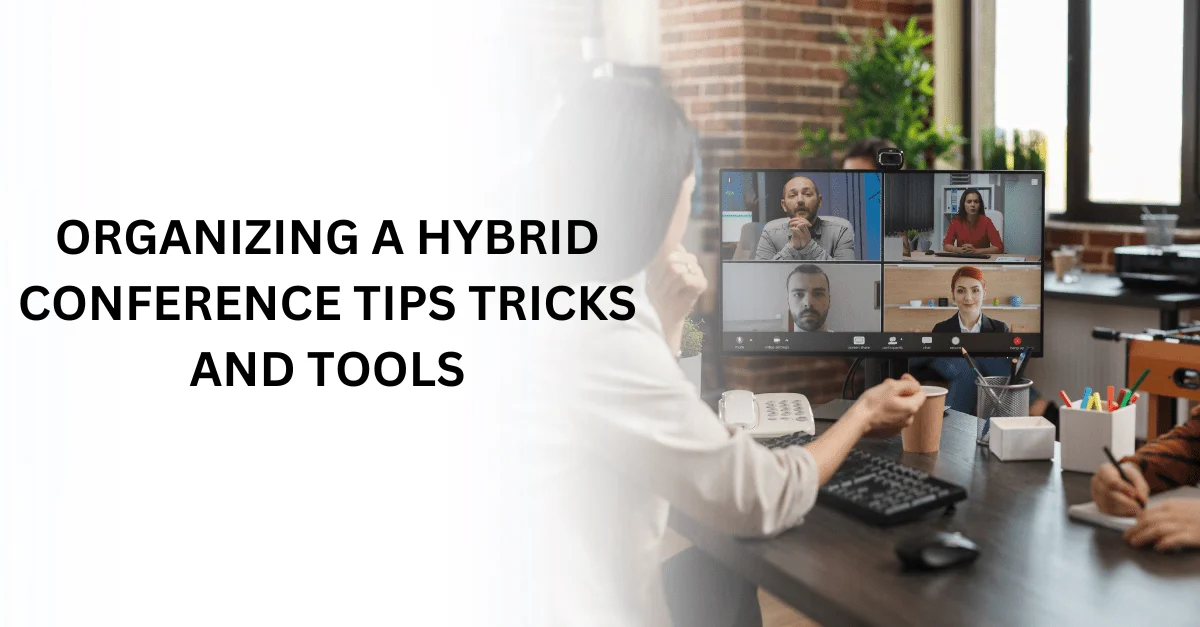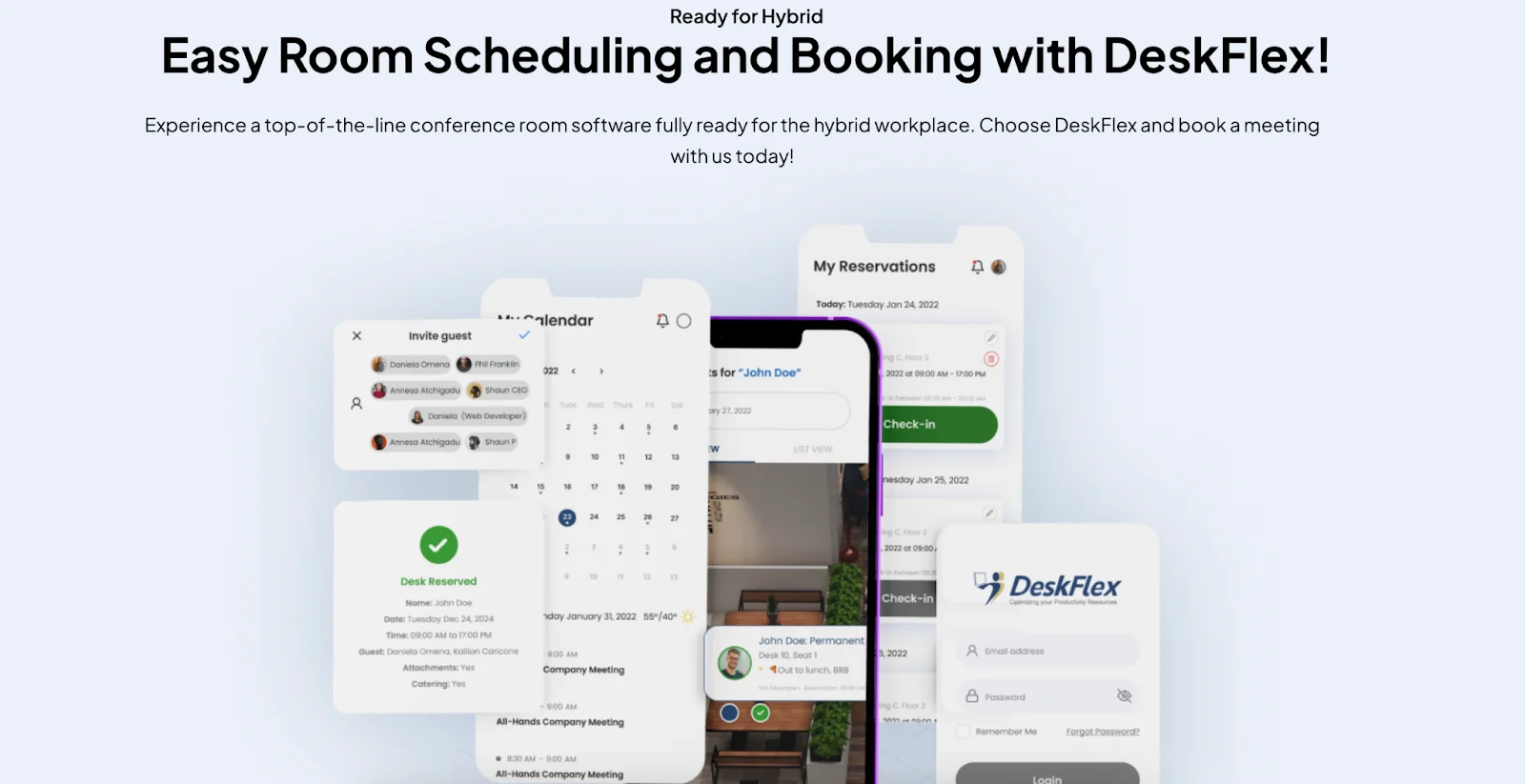Blog

Organizing a Hybrid Conference: Tips, Tricks and Tools
Conferences have changed and keep on changing. Even though in-person meetings are still very important, technology has made it possible to widen the reach through hybrid conferences.
The hybrid conference format has opened up new possibilities for engaging a wider audience, offering flexibility and accessibility that traditional in-person events alone could not achieve.
In this article, we’ll dive into the essential features and major advantages of hybrid conferences, demonstrating how they broaden audience reach, boost engagement, and create a more flexible, inclusive event experience.
What is a Hybrid Conference?
A hybrid conference combines in-person and virtual events, allowing event attendees to choose how they participate.
This format provides the flexibility for prospective attendees to join remotely, broadening the reach of the event to a wider audience.
Hybrid conferences can be held through in-person locations, such as a conference center or hotel, with the option for virtual attendees to join remotely through hybrid events.
3 Benefits of Hybrid Conferences and Virtual Events
Hybrid conferences offer numerous advantages for both organizers and attendees. From reaching a wider audience to providing cost-effective and sustainable solutions, they combine the best of in-person and virtual experiences.
Below, we explore three key benefits of hybrid conferences and virtual events that make them an appealing choice for modern organizations.
Improved Accessibility and Inclusivity
By offering hybrid meetings, hybrid events allow participants who have mobility issues, are in different time zones, or have other constraints to access the event streamed online.
This inclusive approach provides the same opportunity for all attendees engaged to benefit from the conference content.
Cost Effective Solutions
Hybrid meetings can be more cost-effective than traditional in-person events.
Organizations can reduce costs associated with large events in physical venues, travel, and accommodations while still delivering a high-quality experience for all attendees.
Sustainable and Environmentally Friendly
Hybrid conferences can help reduce the carbon footprint connected with in-person events.
Hybrid events contribute to more sustainable practices in the events industry by decreasing the need for travel and minimizing the use of physical resources.
Key Elements of a Successful Hybrid Event
To make sure you will have a successful hybrid event, it is necessary to consider both the in-person and virtual attendees’ experiences.
Here are some key elements to focus on:
Engaging Content for Two Audiences
Create hybrid conference topics that appeal to both in-person attendees and virtual audiences.
This includes keynote presentations, live polls, and interactive question-and-answer sessions that can keep all attendees engaged throughout the event.
Seamless Integration of Technology
Choosing the right tools and hybrid event platforms is critical for managing the event’s online components.
To promote connection between remote and in-person attendees, a strong virtual platform should include networking opportunities, breakout sessions, and live streaming.
Tailored Networking Opportunities
Encourage networking opportunities for both in-person and virtual attendees by offering virtual breakout rooms, sponsored sessions, and social media integration.
This helps build a sense of community and engagement among event attendees, regardless of how they participate.
Host Smarter Hybrid Conferences with DeskFlex
Plan, manage, and optimize your hybrid events with our advanced scheduling and resource management tools.
On-Demand Content
Provide on-demand content for those who cannot attend certain sessions live.
This flexibility allows in-person and remote attendees to access sessions on-demand content at their convenience, making sure they do not miss out on valuable insights and discussions.
Planning a Hybrid Event: Steps to Success
Here’s a step-by-step guide to planning a hybrid event:
Understand Your Target Audience
Knowing your audience, including both in-person and virtual attendees, is very important. Consider the demographics, preferences, and technical capabilities of your attendees to relate the online event experience to their needs.
Choose the Right Tools and Platforms
Select a hybrid event platform that can handle live streaming, breakout sessions, and interactive features like live polls and Q&As. The right tools will ensure a smooth experience for both in-person and online attendees.
Market Your Hybrid Conference Effectively
Create a comprehensive event marketing plan that covers all the information about the conference, how to register, and why attending is beneficial. To reach more people, make use of email campaigns, social media, and other platforms.
Execute with Precision
Test every technological and virtual component, including the audio-visual equipment at the physical venue and the virtual platform, to guarantee flawless execution. Prepare a backup plan for any technical issues to avoid disruptions during the hybrid event.
Evaluation and Follow-Up After the Hybrid Event
After the event, gather feedback from both in-person and virtual attendees to assess their experiences with these virtual sessions. Comparing the event’s performance to the set goals and using this information to improve future virtual and hybrid events.
Beyond the Office: Expanding the Reach of Hybrid Conferences
Hybrid conferences are not limited to business environments. They provide increased accessibility and a wider range of applications across multiple fields.
Let’s look at some examples of how hybrid conferences are used in different sectors:
Educational Hybrid Events
Hybrid conferences are highly effective in the education sector. Universities, colleges, and schools can use this format to live-stream lectures, workshops, and student presentations.
This makes it possible for organizations to interact with professionals, educators, and students wherever they may be.
Hybrid conferences break down geographical barriers, allowing for greater inclusivity in education.
Community Engagement
For community organizations, a powerful approach for interacting with dispersed constituents is to host hybrid events. Whether it’s town hall meetings, public forums, or citizen participation discussions, hybrid conferences provide an inclusive platform that encourages interaction.
Both in-person attendees and virtual attendees can participate in local governance and community discussions, making certain that voices from everywhere are heard.
Professional Development
Hybrid conferences are increasingly used for professional development, offering opportunities for individuals to attend training sessions, industry updates, or networking events.
With hybrid conferences being available, attendees can join remotely, making it easier for them to attend sessions without the need for travel. This flexibility widens access to professional growth opportunities.
3 Essential Tools for a Successful Hybrid Event
The right technology and tools are essential for creating a seamless hybrid conference experience.
Here are all the tools you’ll need:
Event Management Software
An event management platform is crucial for managing registration, ticketing, and communication with attendees.
Hybrid event management software makes planning easier, and registration and conference participation are possible for both in-person and online attendees.
Presentation Tools
One of the keys to a successful hybrid event is the use of interactive presentation tools that support annotations, screen sharing, and real-time collaboration.
These tools help keep both audiences involved, guaranteeing the same level of interaction and participation from virtual attendants as from in-person guests with the content.
Live Streaming Tools
Invest in dependable live-streaming solutions to make sure that the conference materials are accessible to your virtual attendees at all times.
High-quality streaming is important for delivering keynote presentations, breakout sessions, and networking events to your virtual audience without any delays or issues.
A successful hybrid conference needs to be planned with great care and carried out with consideration.
Clear objectives, audience participation, and the appropriate technology tools can help you create an experience that is beneficial, inclusive, and equal for all participants, both in person and virtual.
Interactive Strategies for Hybrid Conferences
Keeping virtual attendees engaged during your virtual event is one of the greatest challenges in hybrid conferences.
Common examples of overcoming this is using engaging techniques that help close the gap and create a feeling of belonging in the community:
Pre-Recorded Q&A
Before the start of the actual hybrid event, let virtual attendees submit questions.
These questions can be answered during a virtual event or in a dedicated Q&A session, ensuring that all attendees feel included in the virtual space discussions.
Live Polling and Quizzes
Interaction can be improved by incorporating live polls and quizzes throughout the virtual events.
These activities during the hybrid event provide a way to measure audience understanding, stimulate interest, and create a fun, interactive environment for both in-person and virtual attendees.
Virtual Breakout Rooms
Use breakout rooms for small group discussions, networking, or brainstorming sessions.
Breakout rooms offer an environment for meaningful interactions, allowing remote attendees to take part in more concentrated and intimate discussions. This creates successful hybrid events that are enjoyable for both in-person and remote attendees.
Interactive Whiteboards and Collaboration Tools
Use virtual whiteboards and other online collaboration tools to interact with virtual attendees during the meeting.
Having access to these tools allows attendees to take the initiative and provide ideas, take notes, and participate in real-time brainstorming sessions.
Social Media Integration
Create a hashtag for the conference and spread the word about it on social media to foster conversation.
Virtual attendees can engage easily during your hybrid conference with other attendees by sharing insights, asking questions, and participating in live chats.
Gamification of Your Hybrid Event
Add an element of fun to make sure to have successful hybrid events with gamification. Award points for activities such as answering quiz questions, participating in discussions, or completing tasks.
Give awards or special recognition to the most engaged participants to promote continued participation.
Dedicated Online Community
Create an online community forum or chat room where the attendees can connect before, during, and after the hybrid event.
This can create lasting connections and offer an opportunity to continue networking even after the event.
You can make sure that virtual guests feel appreciated and included through social media integration, collaborative tools, and online community building. This will result in a more inclusive and successful hybrid event.
Beyond Lectures: Creative Formats for Hybrid Conferences
Hybrid conferences are not limited to traditional lecture formats. Here are some creative ways to keep your attendees engaged during your hybrid event:
Panel Discussions with Remote Participation
Host panel discussions where remote participants can join and contribute their perspectives virtually. This can make discussions more dynamic and diverse.
Live Demonstrations with Remote Interaction
During product launches or skill-building conferences, give remote guests the opportunity to raise questions and seek demonstrations. As a result, they will feel more a part of the event.
Virtual Tours and Immersive Experiences
Give your audience immersive experiences or virtual tours. When researching a new product, venue, or exhibition, attendees at a distance can have the same level of engagement as those there.
Interactive Workshops with Hands-On Activities
Design workshops that include both in-person and virtual components. Provide materials and instructions so that people who are unable to attend in person can still participate in hands-on activities.
Hybrid conferences offer far more than traditional lectures by incorporating creative formats like panel discussions, live demonstrations, virtual tours, and interactive workshops.
Hybrid Conference Planning Checklist: A Step-by-Step Guide
To successfully organize a hybrid conference, meticulous planning is required. This is a detailed checklist to guide you:
Pre-Planning:
- Define goals & objectives: Clearly define what you aim to achieve with your hybrid event, such as knowledge sharing, networking, or product launches.
- Target audience analysis: Identify who will attend in person and virtually by considering demographics like age, job role, and technological proficiency.
- Develop a budget: Plan your budget to cover both physical and virtual event elements, including venue costs, platform fees, and speaker expenses. Make sure that event marketing is included in your budget to successfully reach your target attendees.
- Select a date & time: Think about time zones to accommodate both audiences. Consider offering on-demand content for attendees who can’t join live sessions due to time differences.
Content & Platform Selection:
- Develop engaging content: Craft a program that includes interactive sessions, live Q&A, and breakout rooms. Using tools like polls and group discussions will keep participants actively involved throughout the event.
- Choose a hybrid platform: Make sure the platform supports virtual live streaming, breakout rooms, and audience engagement tools. This guarantees an easy engagement experience for everyone involved, regardless of their location.
- Secure speakers & moderators: Choose speakers comfortable with hybrid settings, and consider inviting remote speakers for a global perspective. Make sure that moderators have the tools necessary to efficiently oversee interactions and transitions between the two platforms.
Marketing & Promotion:
- Develop a marketing strategy: Promote the hybrid event through social media, email campaigns, and ads targeting both physical and remote guests. Make certain that you engage potential attendees on various platforms by customizing your messaging to emphasize the advantages of attending the event on both platforms.
- Develop a website & registration page: Build a user-friendly website that offers detailed event information, including the schedule, speaker bios, and how to participate, whether physically or virtually.
Logistics & Technology:
- Venue selection: Choose a venue with technical facilities for live streaming and smooth delivery of sessions. Also, the location needs to be able to accommodate top-notch audiovisual configurations for a flawless hybrid event.
- Technical rehearsals: Run technical rehearsals to ensure familiarity with the platform. This guarantees that the virtual and physical components of the event run well and helps prevent technological problems during the live event.
- Develop a backup plan: Prepare a contingency plan for technical failures or platform crashes. For physical and virtual guests, having backup equipment and alternate options in place guarantees the least amount of disturbance for your hybrid event.
Post-Conference:
- Record & share sessions: Offer recorded sessions to all attendees, allowing them to revisit the content at their convenience. This is especially useful for those unable to attend hybrid events, and certain sessions live.
- Collect feedback: Distribute post-conference surveys to both physical and virtual attendees to assess the effectiveness of the event.
- Evaluate & analyze performance: Review engagement metrics, registration numbers, and feedback to determine the success of the event and identify areas for improvement.
The Expanding Role of Hybrid Conferences
The idea of hybrid conferences has progressed significantly outside of the business space, discovering uses in diverse industries to involve remote audiences and promote cooperation.
Educational Advancement
Educational institutions can overcome geographical distances using hybrid conferences.
With lectures guest speakers and other events live-streamed, students in remote or underserved areas can join sessions they otherwise wouldn’t have access to.
This inclusive approach helps eliminate barriers based on factors like race, disability, or socioeconomic status while also expanding access to educational materials.
Schools and universities can guarantee equal access to learning resources through using hybrid event technology.
Medical Symposiums and Training
In the medical field, the ability to collaborate and share information is invaluable.
On-demand hybrid events allow practitioners from around the world to join symposiums, training sessions, and real-time demonstrations of advanced medical techniques.
Complex surgeries can be performed and broadcast globally, with remote surgeons monitoring and participating in discussions regardless of their physical location.
Through virtual involvement, medical practices around the world are improved as a result of the global exchange of knowledge and expertise.
Global Arts and Culture Festivals
Around the world, hybrid events have completely changed how art and culture are delivered.
Nowadays, live events like plays or concerts are accessible to audiences worldwide, and viewers may also see performers in action, remote attendees can engage directly with artists or other viewers, creating a shared cultural experience.
The hybrid event model breaks down physical barriers, allowing people to connect with art and culture like never before.
Environmental Advocacy and Citizen Science
Environmental groups and other organizations are using hybrid events as a means of bringing together international policymakers, scientists, and activists.
Real-time data transmissions, panel discussions, and event content on environmental issues are broadcast to a worldwide audience.
This approach promotes awareness and encourages cooperation in finding answers to global issues.
Streamline Conference Room Bookings with DeskFlex
With DeskFlex’s workplace management software, managing your hybrid office space is easier than ever. Whether you need to reserve meeting rooms, desks, or shared workspaces, DeskFlex allows you to make, modify, or cancel bookings in just a few clicks.
Stay organized and efficient while reducing unused office space. With 3D floor maps and real-time availability, you can gain control over your office layout. 30 – Day Trial and Live Demos Available. and start simplifying your workspace management today.
FAQs About Hybrid Conference
What are the major challenges of hosting a hybrid conference?
Technical glitches are the most common challenge. A powerful internet connection and a reliable platform are crucial. To prevent interruptions, make sure that all equipment has been tested in advance and that a backup plan is in place.
A well-planned program that promotes interactive engagement and effective communication to keep both audiences engaged throughout the hybrid conference is necessary for a successful virtual event.
Handling both in-person and remote components simultaneously requires an efficient team. Make sure there are dedicated staff to manage the in-person event, virtual presentations, and audience interactions smoothly.
How can I ensure a smooth transition between in-person and remote presentations?
Give speakers all the details and guidance on how to interact with both in-person and remote guests, manage their time efficiently, and use the hybrid event platform.
Having clear guidelines makes it easier for both groups to interact during the hybrid event.
To guarantee a smooth experience for all involved, these sessions should address the technological setup, presentation flow, and transitions between in-person and remote presentations.
Assign a moderator to oversee the changes between physical and online presentations. This ensures that both your physical and virtual attendees remain engaged and connected throughout the hybrid event.
How do I measure the success of a hybrid event?
Keep track of how many people have registered to attend the in-person event and the virtual event.
Consider offering distinct registration categories customized to each group in order to manage the hybrid conference’s logistics and attendees’ expectations.
Measure engagement by monitoring key indicators such as participation in polls, chat activity, and breakout room interactions.
These metrics, along with other platform tools, provide valuable insight into how engaged both in-person and online attendees are during your hybrid events.
Is a hybrid conference cheaper or more costly as compared to a normal or conventional conference?
While there may be additional infrastructure expenses, such as a Zoom hybrid meeting platform, venue technology, and staffing, a hybrid conference can attract more attendees.
Due to lower travel and lodging costs for people who are unable to attend in person, this higher participation can help reduce costs and make the event more affordable overall.
Is it possible to have the conference sessions on record, so that I can attend them online at a later time?
Yes, research shows that most hybrid event platforms offer recording functionalities, but take note that when capturing audio and video during a hybrid conference, it is important to obtain consent from both presenters and attendees.
Clearly state the recording policy in advance to ensure everyone is informed and comfortable with the process.















































 Support
Support  Demo
Demo  Blog
Blog 

